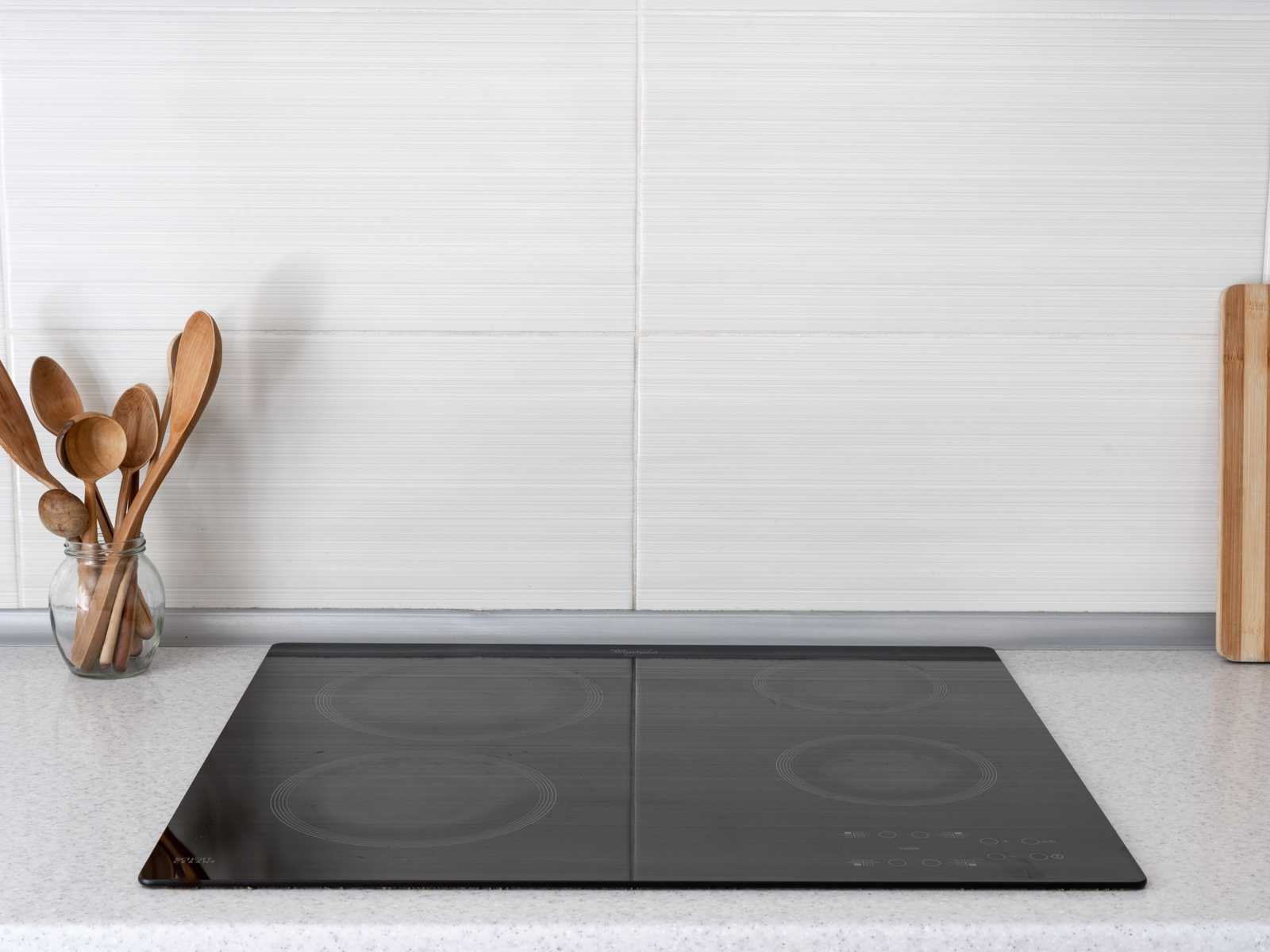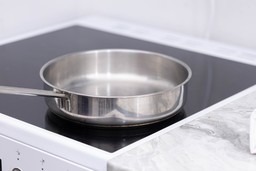Induction vs. Electric Stoves
By Kevin Purdy

Table of contents
Induction is better, but more expensive
What is induction cooking? How is it different than electric?
Induction is better, but more expensive
If your electric stove needs replacing, or you’re buying a new model after a renovation, you might be comparing stoves. Electric and induction can seem very similar in appearance and operation, if not always in price. Which should you pick?
Induction stoves offer a tantalizing upgrade over electric: they’re faster, safer, and warm up your home less. They can change the way you cook, and how soon meals are done, for the better. And if you’ve already got the space and wiring for an electric stove, most induction stoves are a simple replacement.
In this article, we’ll explore the differences between state-of-the-art induction stoves and traditional electric cooktops.
What is induction cooking? How is it different than electric?
Induction cooking does use electricity, but it’s not “electric,” the way most people describe a stove. Here’s how induction differs from traditional electric stoves and cooktops.
An electric stove sends electricity into a resistive coil. In some cases the coil is exposed; in other cases it sits underneath a glass ceramic surface. Resistance creates heat, which radiates out from the coil and into your pan or pot. It’s conduction because heat is conducted indirectly to the pan, and eventually the food inside.
An induction stove powers an electromagnet, creating an oscillating magnetic field that induces currents inside the metals in the pan. The metal heats up, and your food gets cooked. It’s more efficient—90% energy efficiency, versus 74% for electric and 40% for gas. That efficiency also means far less heat is radiated out from your stove and into your living space, which is nice if you’re cooking on a hot summer day.
Induction has a number of benefits over standard electric:
- Faster cooking, especially boiling liquids
- Faster response to temperature changes
- Less waste heat (cooler kitchen)
- Safer cooking, without coils that stay hot long after cooking
- Built-in timers and safety features against leaving a burner on
- Easier clean-up than with burners and grates
Costs
Upfront purchase
Induction stoves cost more upfront than similar electric stoves, at least for now. Full-size induction stoves are a newer product, and most have more advanced capabilities than their electric counterparts (though both can come with additional premium features).
Browsing major appliance vendors, electric stoves cost between $550-$2,000, from the most basic, exposed-coil, knob-operated model to flat-top, air-frying models that clean themselves with steam.
In the same stores, most induction stoves start at $1,200 and run up to $2,000, within mainstream brands and common sizes. Premium models with more features start at $3,000.
You’ll also likely have to have your induction stove delivered, because your nearby appliance store may not have a model you like in stock. Delivery and installation are usually free on such online purchases.
Installation
If you’re switching from electric to induction, you likely won’t need to do much. Induction stoves require a dedicated 220-volt outlet connected to a 40-50-amp breaker, but that’s also what electric stoves should have. Assuming you have the wiring, and ventilation, in place, you’ll be good to go.
If you’re switching from gas, it’s a different job. You’ll need a licensed electrician to install that outlet and run that high-capacity wire back to your outlet. And you’ll want a plumber to cap the gas line and shut off the line.
Cookware
Image via Marco Verch Professional/Flickr.
Induction cooking works through magnetism. If a magnet doesn’t stick to a pot or pan, it’s not likely to work with an induction cooktop. So you might need to invest in some new cookware for an induction stove—take this as a plus or minus, depending on how you feel about your pans.
Many pans these days are labeled as induction-ready. Others may not be, but inherently work well: cast iron, some kinds of steel, Dutch ovens (which are cast iron enameled with glass), and some higher-end non-stick pans.
Having the wrong kind of pan won’t hurt anything; the induction cooktop will show an error code and simply not power up.
Cooking techniques
Induction cooking is a bit faster than electric cooking, and your cooktop will react faster when you adjust levels. That’s not a bad thing, in most cases. But if you’re used to a certain rhythm, an amount of delay, you’ll want to watch your food more closely when you first start out with induction.
Because induction requires direct contact with the pan, you’ll be better off stirring food in the pan rather than pulling it off the burner to toss food around. You can still flip if you want; your stove will just complain about a lack of contact, and you’ll have a minute or so to return the pan and keep cooking before it turns off. Most induction users get used to this quickly, but it’s certainly an adjustment.
Appearance
Induction stoves look almost exactly like a flat-top electric stove. Their elements (or “burners”) are hidden underneath a smooth, ceramic-glass top. And their ovens are typically the same kind of electric–powered space, whether they offer convection, air-frying, or other versions of it.
Unlike more affordable electric stoves, the relatively lower-cost induction stoves tend to feature buttons and screens rather than dials. It’s helpful when setting the more precise temperatures induction can achieve: 300 Fahrenheit instead of “medium.” But many appliance manufacturers make induction stoves with knobs if that’s your preference.
Maintenance, repair, and care
Caring for an induction stove is the same as caring for a flat-top electric stove, if maybe a bit easier. Because the heat comes from inside the cookware, rather than radiated from underneath, food that gets onto the cooktop is less burned into it, making it somewhat easier to wipe away after cooking. And, because the cooktop doesn’t stay hot as long after cooking, you can get to that gunk faster. For the toughest stains, however, you’ll want a glass scraper.
As with electric flat-top stoves, you want to avoid moving heavy pots and pans around on the surface of your induction stove, so you don’t scratch the surface. This will be reinforced by the stove, somewhat, because lifting a pan off the cooktop will cause an error code and cut off that section’s power. It’s especially important with cast iron, which works well with induction, but has a rougher surface.
Most importantly, don’t drop heavy pots or pans directly onto the cooktop, or else you could chip or even shatter the cooktop.
Beyond that, you should follow the stove’s maintenance and cleaning procedures.
Environmental benefits
Both induction and electric stoves rely on electricity, so they’re inherently better than a gas stove. By going (or staying) electric, you’re reducing the demand for “natural gas,” which is mostly methane, a greenhouse gas that warms the earth at 80 times the rate of carbon dioxide.
As noted earlier, induction is more energy efficient than electric (and they’re both far more efficient than gas), but you’re not likely to see a big swing in your electric bill. What you are seeing is a home that’s ready for a future with far less carbon. Electrifying your home, with as many efficient devices as possible, helps move us all closer to a world without fossil fuels.
Is there any reason to go with an electric stove?
The main drawback of induction is the higher upfront cost. For most homeowners deciding between an induction versus electric stove, it’s really a question of how much you’re willing to pay for a better cooking experience.
Many professional chef’s love induction stoves. But the reality is that many people either don’t cook that much, or don’t really care about the performance of their stove.
So if money’s tight, and the idea of a more responsive cooktop doesn’t speak to you, we recommend going with a traditional electric stove.

